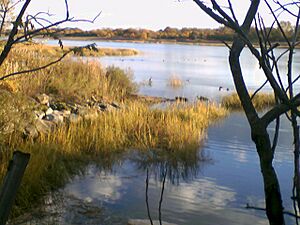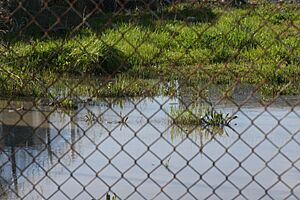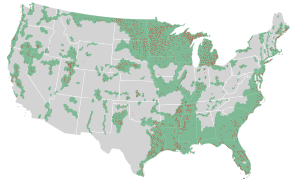Wetlands of the United States facts for kids


Wetlands are special places where land meets water. They are areas that are often wet, either from water on the surface or from water underground. Think of them as places that are wet enough to support plants that love living in soggy soil. These areas include swamps, marshes, and bogs.
Wetlands are super important for many reasons. They help clean our water, store extra water (which can prevent floods), and are home to lots of different plants and animals. They also help refill underground water sources and act like a sponge, soaking up extra nutrients.
The United States is part of an international agreement called the Ramsar Convention. This agreement helps protect wetlands around the world. In the U.S., there are rules to protect wetlands. For example, farmers might lose government help if they change wetlands on their land. Also, for many years, the U.S. government has aimed for "no net loss" of wetlands. This means that if some wetlands are lost, new ones should be created or restored somewhere else.
Some wetlands in the U.S. are protected by a law called the Clean Water Act. It can be tricky to figure out exactly where a wetland ends and dry land begins. Nature doesn't draw clear lines! But scientists use three main things to define a wetland:
- Special "wet" soil (hydric soil).
- Plants that grow well in wet conditions (wetland vegetation).
- Enough water present for a certain amount of time (hydrology).
These rules help make sure our water stays clean and our environment is protected. Experts, often with science degrees, use a special manual to figure out where wetland boundaries are. This process is called a "wetland delineation."
Contents
Why Wetlands Are Disappearing
Sadly, a lot of wetlands in the United States have been lost. Since the 16th century, more than half of the original wetlands in the U.S. (not counting Alaska) have been damaged or destroyed. This is a big problem because wetlands are so important for our environment.
Mapping U.S. Wetlands
The U.S. Fish and Wildlife Service has a special program called the National Wetlands Inventory (NWI). This program creates maps and gathers information about wetlands and other water habitats across the U.S. They also publish reports about how wetlands are changing.
The NWI has a website with a "Wetlands Mapper." This online tool lets people see where wetlands are located. It uses a huge database of information to show maps and details about wetlands. This information is available to governments and the public. It helps everyone understand and protect these important areas.
How Wetland Maps Are Made
The NWI uses a large digital database to store all its wetland information. This database covers different parts of the U.S., including Alaska, Hawaii, Puerto Rico, and other islands. The maps are very detailed and use a standard way of showing locations.
This wetland database is one of the biggest of its kind in the world! People use this information a lot to find, protect, and restore wetlands across America. In 2008 alone, there were over 56 million requests for data from their website. This shows how valuable this information is for protecting our natural world.
New Wetland Data Each Year
Every year, more and more wetland data is added to the database. In 2008, information for over 66 million acres was added. This included updated maps, new areas that hadn't been mapped before, and older maps that were converted into digital format.
Today, the database has maps for about 64% of the main U.S. states, 30% of Alaska, and almost all of Hawaii and Puerto Rico. The amount of data keeps growing as old maps are made digital and new information is collected. Other groups, like the United States Army Corps of Engineers, also share their wetland data, which helps make the maps even more complete.


